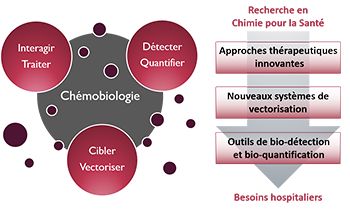- ⌂
-
Le DPM
Les Equipements
L'Environnement
Zoom sur... Le Bâtiment André Rassat
Nommé d'après une figure tutélaire de la chimie grenobloise, ce bâtiment est recouvert d’une double peau en feuille métallique qui apporte une protection thermique sur 3 côtés et crée une unité architecturale favorisant l'intégration parmi les arbres du site.
-
Thématiques
Le Thème
« Approches thérapeutiques innovantes »De nouvelles solutions thérapeutiques, de la cible biomacromolécu-laire émergente aux approches originales pour traiter les maladies
Le Thème
« Nouveaux systèmes de vectorisation »Combiner les propriétés d’inclusion de principes actifs, de franchisse-ment de barrières, d’adressage et de relar-gage en milieu vivant
Le Thème
« Outils de bio-détection et bio-quantification »Des dispositifs analytiques originaux pour la détection de cibles, de l’ion au micro-organisme en milieu complexe
Zoom sur... La Chémobiologie

-
Équipes
L'Équipe « COMET »
« COMET » développe la conception rationnelle, la synthèse et/ou l'extraction de composés à forte diversité/complexité comme nouveaux agents thérapeutiques et outils moléculaires pour la pénétration cellulaire ou la détection de biomolécules, actifs in vivo.L'Équipe « NOVA »
« NOVA » utilise des acides nucléiques fonctionnels comme éléments de reconnaissance pour des applications thérapeutiques ou diagnostiques, comme la sélection d'oligonucléotides, ou le développement de dispositifs d'analyses et de nanovecteurs.Les Services
-
Productions
Les Publications
La Vulgarisation
Les JSM
Zoom sur... La 12ème JSM (15 juin 2023)
Le DPM organise des journées scientifiques consacrées au médicament. L'objectif est de rassembler les spécialistes académiques et industriels autour d'une thématique. 2023 : Apports de la Chimie Click et de la Lumière en Chemobiologie
-
Partenariats
Les Formations
Les Consortiums
Les Financements
Zoom sur... L'environnement Grenoblois
Le DPM est un acteur central sur le bassin grenoblois en chimie, biologie et santé, lié au CHU Grenoble Alpes et à de nombreuses autres organisations : Pole de Recherche CBS, ICMG, Labex ARCANE, EUR CBH, Institut Carnot Polynat, Réseau GREEN.
Article
- Projet
- Denis WOUESSIDJEWE, Annabelle GEZE, Luc CHOISNARD, Delphine LEVILLY, Véronique BLANC-MARQUIS,
- Titre
- Biodistribution and preliminary toxicity studies of nanoparticles made of Biotransesterified β–cyclodextrins and PEGylated phospholipids
-
[Full paper
 ]
] - Auteurs
- P. Perret, S. Bacot, A. Gèze, A. Gentil Dit Maurin, M. Debiossat, A. Soubies, V. Blanc-Marquis, L. Choisnard, J. Boutonnat, C. Ghezzi, J.L. Putaux, C. Lancelon-Pin, L.M. Riou,⁎, D. Wouessidjewe
- Edition
- Materials Science & Engineering C 2018, 85, 7-17
- Année
- 2018
- Résumé
- Background: The modification of β-cyclodextrins (βCDs) by grafting alkyl chains on the primary and/or secondary face yields derivatives (βCD-C10) able to self-organize under nanoprecipitating conditions into nanoparticles (βCD-C10-NP) potentially useful for drug delivery. The co-nanoprecipitation of βCD-C10 with polyethylene glycol (PEG) chains yields PEGylated NPs (βCD-C10-PEG-NP) with potentially improved stealthiness. The objectives of the present study were to characterize the in vivo biodistribution of βCD-C10-PEG-NP with PEG chain length of 2000 and 5000 Da using nuclear imaging, and to preliminarily evaluate the in vivo acute and extended acute toxicity of the most suitable system. Research design and methods: The in vivo and ex vivo biodistribution features of naked and decorated nanoparticles were investigated over time following intravenous injection of 125I-radiolabeled nanoparticles to mice. The potential toxicity of PEGylated βCD-C10 nanosuspensions was evaluated in a preliminary in vivo toxicity study involving blood assays and tissue histology following repeated intraperitoneal injections of nanoparticles to healthy mice. Results: The results indicated that βCD-C10-PEG5000-NP presented increased stealthiness with decreased in vivo elimination and increased blood kinetics without inducing blood, kidney, spleen, and liver acute and extended acute toxicity. Conclusions: βCD-C10-PEG5000-NPs are stealth and safe systems with potential for drug delivery.




 Annuaire
Annuaire Contact
Contact Plan d'accès
Plan d'accès ENG
ENG Login
Login



